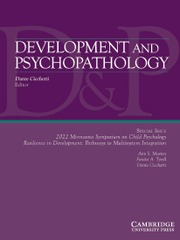Crossref Citations
This article has been cited by the following publications. This list is generated based on data provided by
Crossref.
Sluyter, Frans
Arseneault, Louise
Moffitt, Terrie E.
Veenema, Alexa H.
de Boer, Sietse
and
Koolhaas, Jaap M.
2003.
Toward an Animal Model for Antisocial Behavior: Parallels Between Mice and Humans.
Behavior Genetics,
Vol. 33,
Issue. 5,
p.
563.
Gregory, Alice M.
Eley, Thalia C.
and
Plomin, Robert
2004.
Exploring the Association Between Anxiety and Conduct Problems in a Large Sample of Twins Aged 2–4.
Journal of Abnormal Child Psychology,
Vol. 32,
Issue. 2,
p.
111.
Snyder, James
Prichard, Joy
Schrepferman, Lynn
Patrick, M. Renee
and
Stoolmiller, Mike
2004.
Child Impulsiveness—Inattention, Early Peer Experiences, and the Development of Early Onset Conduct Problems.
Journal of Abnormal Child Psychology,
Vol. 32,
Issue. 6,
p.
579.
VIDING, ESSI
2004.
On the Nature and Nurture of Antisocial Behavior and Violence.
Annals of the New York Academy of Sciences,
Vol. 1036,
Issue. 1,
p.
267.
Snyder, Lori Anderson
Chen, Peter Y.
Grubb, Paula L.
Roberts, Rashaun K.
Sauter, Steven L.
and
Swanson, Naomi G.
2004.
Exploring Interpersonal Dynamics.
Vol. 4,
Issue. ,
p.
1.
LARSSON, JAN-OLOV
LARSSON, HENRIK
and
LICHTENSTEIN, PAUL
2004.
Genetic and Environmental Contributions to Stability and Change of ADHD Symptoms Between 8 and 13 Years of Age: A Longitudinal Twin Study.
Journal of the American Academy of Child & Adolescent Psychiatry,
Vol. 43,
Issue. 10,
p.
1267.
Gelhorn, Heather L.
Stallings, Michael C.
Young, Susan E.
Corley, Robin P.
Rhee, Soo Hyun
and
Hewitt, John K.
2005.
Genetic and environmental influences on conduct disorder: symptom, domain and full‐scale analyses.
Journal of Child Psychology and Psychiatry,
Vol. 46,
Issue. 6,
p.
580.
Ruocco, Anthony C.
2005.
Reevaluating the distinction between Axis I and Axis II disorders: The case of borderline personality disorder.
Journal of Clinical Psychology,
Vol. 61,
Issue. 12,
p.
1509.
Rey, Joseph M.
Sawyer, Michael G.
and
Prior, Margot R.
2005.
Similarities and Differences Between Aggressive and Delinquent Children and Adolescents in a National Sample.
Australian & New Zealand Journal of Psychiatry,
Vol. 39,
Issue. 5,
p.
366.
Rey, Joseph M.
Sawyer, Michael G.
and
Prior, Margot R.
2005.
Similarities and Differences Between Aggressive and Delinquent Children and Adolescents in a National Sample.
Australian & New Zealand Journal of Psychiatry,
Vol. 39,
Issue. 5,
p.
366.
Walker, Julian S.
2005.
The Maudsley Violence Questionnaire: initial validation and reliability.
Personality and Individual Differences,
Vol. 38,
Issue. 1,
p.
187.
E. Moffitt, Terrie
2005.
Vol. 55,
Issue. ,
p.
41.
Tuvblad, Catherine
Eley, Thalia C.
and
Lichtenstein, Paul
2005.
The development of antisocial behaviour from childhood to adolescence.
European Child & Adolescent Psychiatry,
Vol. 14,
Issue. 4,
p.
216.
Tackett, Jennifer L.
Krueger, Robert F.
Iacono, William G.
and
McGue, Matt
2005.
Symptom-based subfactors of DSM-defined conduct disorder: Evidence for etiologic distinctions..
Journal of Abnormal Psychology,
Vol. 114,
Issue. 3,
p.
483.
Blazei, Ryan W.
Iacono, William G.
and
Krueger, Robert F.
2006.
Intergenerational transmission of antisocial behavior: How do kids become antisocial adults?.
Applied and Preventive Psychology,
Vol. 11,
Issue. 4,
p.
230.
Brook, David W.
Brook, Judith S.
Rubenstone, Elizabeth
and
Zhang, Chenshu
2006.
Aggressive Behaviors in the Adolescent Children of HIV-positive and HIV-negative Drug-abusing Fathers.
The American Journal of Drug and Alcohol Abuse,
Vol. 32,
Issue. 3,
p.
399.
Grotevant, Harold D.
van Dulmen, Manfred H. M.
Dunbar, Nora
Nelson‐Christinedaughter, Justine
Christensen, Mathew
Fan, Xitao
and
Miller, Brent C.
2006.
Antisocial Behavior of Adoptees and Nonadoptees: Prediction from Early History and Adolescent Relationships.
Journal of Research on Adolescence,
Vol. 16,
Issue. 1,
p.
105.
Granic, Isabela
and
Patterson, Gerald R.
2006.
Toward a comprehensive model of antisocial development: A dynamic systems approach..
Psychological Review,
Vol. 113,
Issue. 1,
p.
101.
Vierikko, Elina
Pulkkinen, Lea
Kaprio, Jaakko
and
Rose, Richard J.
2006.
Genetic and environmental sources of continuity and change in teacher‐rated aggression during early adolescence.
Aggressive Behavior,
Vol. 32,
Issue. 4,
p.
308.
Prinzie, P.
Onghena, P.
and
Hellinckx, W.
2006.
A cohort-sequential multivariate latent growth curve analysis of normative CBCL aggressive and delinquent problem behavior: Associations with harsh discipline and gender.
International Journal of Behavioral Development,
Vol. 30,
Issue. 5,
p.
444.

